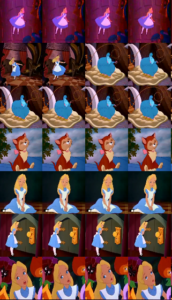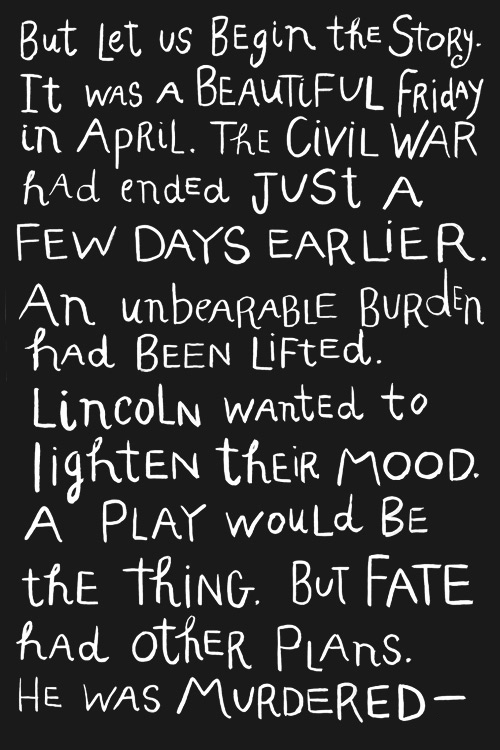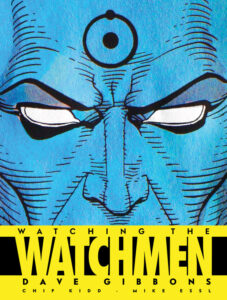Juzguen ustedes mismos… Disney’s Alice in Wonderland remix video
We live in public
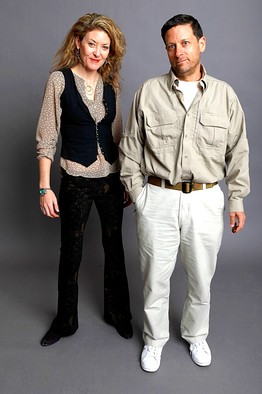
“‘We Live in Public’ follows the rise and fall of Mr. Harris, who made $80 million when his Internet-research company, Jupiter Communications, went public in the early 1990s. He used his dot-com millions to fund experimental art projects — surveillance-themed works that seemed to anticipate today’s over-sharing Internet culture of blogs, Twitter and social-networking sites. Mr. Harris installed 32 cameras in the loft he shared with his girlfriend.
In love with A. Lincoln
RIP! a remix manifiesto
Hitchcock portfolio, fotografía by Vanity Fair
En su número de Marzo del año pasado, la revista Vanity Fair se planteo capturar el suspense de un montaje de los clásicos de Hitchcock. Fotos de Keira Knightley, Scarlett Johansson, Javier Bardem o Seth Rogen, participando de unos sets cuidadosamente montados para recrear la magia de algunos de los míticos rodajes del ingles que mejor supo tejer fobias e intrigas, trasladándolas al celuloide. Julian Broad, Norman Jean Roy, Mark Seliger, y Art Streiber al otro lado de la lente, ahí es nada.
La lista completa incluye a Casey Affleck, Javier Bardem, Josh Brolin, Julie Christie, Marion Cotillard, Robert Downey Jr., Ben Foster, Jodie Foster, Emile Hirsch, Scarlett Johansson, Keira Knightley, Jennifer Jason Leigh, James McAvoy, Omar Metwally, Gwyneth Paltrow, Seth Rogen, Eva Marie Saint, Charlize Theron, Naomi Watts, Tang Wei, y Renée Zellweger…
Continue reading “Hitchcock portfolio, fotografía by Vanity Fair”
Watching The Watchmen
Kittinger, el hombre que callo a la tierra. Tres veces.
MovableType 4.2
Movable type nuevo, vida nueva. 4.2 ya, que viejos nos hacemos. Teóricamente están solucionados los problemas con la DDBB y los comentarios, ya se puede comentar. Esa y otro montón de pequeñas putadas que me hacia la versión anterior y que no cuento por no aburrir, pero que han estado a nada de empujarme hacia wordpress. No lo descarto todavía, así que si alguien me da un argumento de peso para el cambio sera sumamente agradecido…
The atheist bus campaign

Con este fabuloso copy se lanzaba el día 21 de este mes,
“The atheist bus campaign”. Resultado de una campaña de
recolección de fondos en la cual cerca de 1000 personas decidieron
aportar fondos para contrarrestar una injusta parcialidad pro-religiosa
en el mundo de la publicidad. Ademas de las 877 aportaciones de 5
libras, la “British Humanist Association” y el profesor Richard
Dawkins (autor de The God Delusion) contribuyeron para las 11000
libras necesitadas. Juntos, han conseguido financiar la
publicidad en 30 buses con el eslogan “There’s probably no
God. Now stop worrying and enjoy your life.” bien impreso en
un costado.
“Religion is accustomed to getting a free ride – automatic
tax breaks, unearned ‘respect’ and the right not to be ‘offended’,
the right to brainwash children,” citando al profesor Dawkins. “Even on the buses, nobody thinks twice when they see a
religious slogan plastered across the side. This campaign to put
alternative slogans on London buses will make people think – and
thinking is anathema to religion.” En palabras de Hanne Stinson, directora
ejecutiva del BHA, “If it raises a smile as well as making
people think, so much the better.”

Varios
aspectos curiosos y estudiables en esta campaña, por un lado que
surge a raíz de un articulo de Ariane Sherine, desde Comment is
free, titulado “Atheists – gimme five”. Un artículo que
comienza con una entradilla especialmente acertada, “Since when is
it OK to spread the fear of God from the side of a bus? Let’s get
together and distribute reassurance”, referente a una campaña que
en ese momento estaba utilizando como soporte los buses, gestionados
por CBS
Outdoor Advertising (los mismos que han gestionado esta campaña, todo sea dicho).
Otro, por si alguno se lo esta
preguntando, es la inclusión de ese “Probably’s” en el copy, responde a la legislación publicitaria británica, en concreto a
determinadas reglas del CAP Code, que regula la publicidad no
radiada/televisada.
Un planteamiento mas que razonable, con
una iniciativa notablemente fructífera, que la gente CiF ha sabido
capitalizar y llevar a cabo. Completando con el paquete de
herramientas disponibles a mano, un website, un grupo de Facebook y
por supuesto desde el CiF (Cif es el espacio online que The
Guardian y The Observer han creado para concentrar la actividad y
comentarios de sus lectores y algunos bloggers de la casa), la
campaña se puede definir como un rotundo éxito, con 83.000 libras
recaudadas en solo los dos primeros días, y un debate generado en
los medios británicos sin precedentes. Sospecho que muy por encima
de los resultados esperados por los organizadores de este el primer
anuncio británico ateo.
Visualización de datos para Last.fm
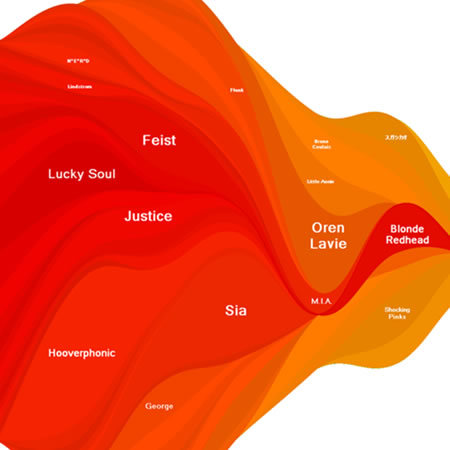
Last.fm es uno de mis productos web favoritos. Ya se lo mencionaba en una entrada dedicada a Songbird (en otra vida, cuando actualizaba el blog con una frecuencia que no diera vergüenza…) Funciona estupendamente, me salva la vida cuando tengo que trasladarme a algún lado y no quiero cargar con el disco duro, ni extrañar mi música donde sea que este. Su funcionamiento es bastante simple, registra la música a medida que la reproduces, generando luego una “emisora” con tus temas favoritos y otros que te sugiere, basándose en las preferencias de tus “vecinos”, musicalmente hablando. Casi cualquier reproductor de audio que utilices es compatible. Otro de los servicios de música online que también uso son Deezer y Blip.fm, con otro cariz ligeramente distinto, aunque a este ultimo no le he encontrado el punto hasta hace bien poco.
Es un servicio bastante bien planteado, que esta funcionando bien como producto, con una comunidad correctamente estimulada y con una estrategia de difusión bien organizada (widgets, soporte limitado a la comunidad de desarrolladores, desarrollos para iphone y otras plataformas…). Rebuscando un poco me encontré con este pequeño programa de windows, Last FM Extra Stats, que genera gráficas de distintos tipos utilizando tu historial de escuchas. La visualización de datos es un tema que me fascina, mas si el resultado es tan delicioso como este.
Mis sabores musicales favoritos tienen esta pinta. Los suyos? Prueben y me cuentan.
